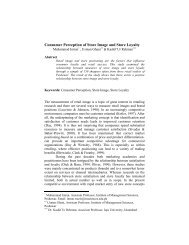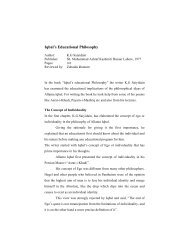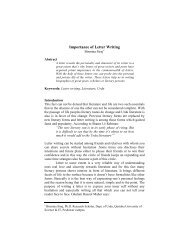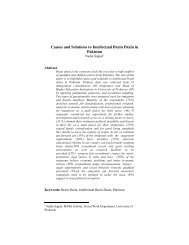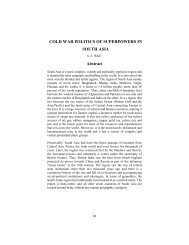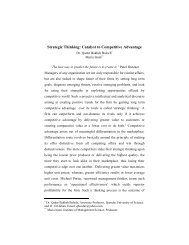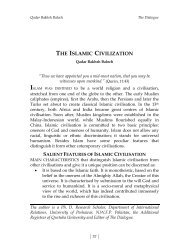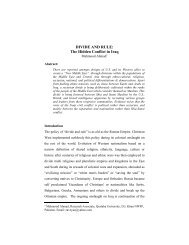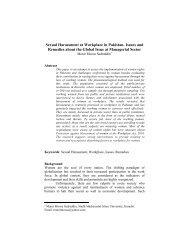Impact of Population Growth on Current Account Balance of Pakistan
Impact of Population Growth on Current Account Balance of Pakistan
Impact of Population Growth on Current Account Balance of Pakistan
You also want an ePaper? Increase the reach of your titles
YUMPU automatically turns print PDFs into web optimized ePapers that Google loves.
<str<strong>on</strong>g>Impact</str<strong>on</strong>g> <str<strong>on</strong>g>of</str<strong>on</strong>g> <str<strong>on</strong>g>Populati<strong>on</strong></str<strong>on</strong>g> <str<strong>on</strong>g>Growth</str<strong>on</strong>g> <strong>on</strong> <strong>Current</strong> <strong>Account</strong><br />
<strong>Balance</strong> <str<strong>on</strong>g>of</str<strong>on</strong>g> <strong>Pakistan</strong><br />
Atif Ali Jaffri, ∗ Tanveer A. Naveed, ∗∗ Rooma Asjed ∗∗∗ &<br />
Isma Khato<strong>on</strong> ∗∗∗∗1<br />
Abstract<br />
<strong>Pakistan</strong> being 6 th most populous country in the world has 177<br />
milli<strong>on</strong> populati<strong>on</strong> with total fertility rate 3.5 per woman and<br />
populati<strong>on</strong> growth rate 2.05 percent. Family planning<br />
indicators reflect that <strong>Pakistan</strong> has comparatively lowest<br />
positi<strong>on</strong> in the regi<strong>on</strong> as well as in Islamic countries.<br />
<str<strong>on</strong>g>Populati<strong>on</strong></str<strong>on</strong>g> growth rate is an important determinant <str<strong>on</strong>g>of</str<strong>on</strong>g> current<br />
account balance, however, no previous study has checked<br />
impact <str<strong>on</strong>g>of</str<strong>on</strong>g> populati<strong>on</strong> growth <strong>on</strong> CAB in <strong>Pakistan</strong>. This study<br />
investigates the impact <str<strong>on</strong>g>of</str<strong>on</strong>g> populati<strong>on</strong> growth <strong>on</strong> current<br />
account balance as percentage <str<strong>on</strong>g>of</str<strong>on</strong>g> GDP (CABGDP) <str<strong>on</strong>g>of</str<strong>on</strong>g><br />
<strong>Pakistan</strong> by applying Autoregressive Distributive Lag (ARDL)<br />
approach <str<strong>on</strong>g>of</str<strong>on</strong>g> co-integrati<strong>on</strong> for the period 1984-2010. The<br />
findings <str<strong>on</strong>g>of</str<strong>on</strong>g> the study show that increase in populati<strong>on</strong> growth<br />
worsens CABGDP <str<strong>on</strong>g>of</str<strong>on</strong>g> <strong>Pakistan</strong> in the l<strong>on</strong>g run. The negative<br />
sign and significance <str<strong>on</strong>g>of</str<strong>on</strong>g> coefficient <str<strong>on</strong>g>of</str<strong>on</strong>g> error correcti<strong>on</strong> term in<br />
the short run model also c<strong>on</strong>firms l<strong>on</strong>g run relati<strong>on</strong>ship<br />
between populati<strong>on</strong> growth and CABGDP in <strong>Pakistan</strong>.<br />
Keywords: <strong>Current</strong> account balance, <str<strong>on</strong>g>Populati<strong>on</strong></str<strong>on</strong>g> growth, Demographic<br />
transiti<strong>on</strong>.<br />
Introducti<strong>on</strong><br />
<strong>Pakistan</strong>, being 6 th most populous country in the world has 177 milli<strong>on</strong><br />
populati<strong>on</strong> with total fertility rate 3.5 per woman and populati<strong>on</strong> growth<br />
rate 2.05 percent (Ec<strong>on</strong>omic Survey <str<strong>on</strong>g>of</str<strong>on</strong>g> <strong>Pakistan</strong> 2010-11). On the <strong>on</strong>e<br />
hand, 60 percent populati<strong>on</strong> c<strong>on</strong>sists <str<strong>on</strong>g>of</str<strong>on</strong>g> working age, more than 30<br />
percent <str<strong>on</strong>g>of</str<strong>on</strong>g> populati<strong>on</strong> c<strong>on</strong>sists <str<strong>on</strong>g>of</str<strong>on</strong>g> youth (15-29 years) and two third <str<strong>on</strong>g>of</str<strong>on</strong>g><br />
populati<strong>on</strong> is below 30 years old thus providing opportunity <str<strong>on</strong>g>of</str<strong>on</strong>g><br />
∗ Dr. Atif Ali Jaffri, Associate Director/ HoD Ec<strong>on</strong>omics, University <str<strong>on</strong>g>of</str<strong>on</strong>g> Gujrat.<br />
Email: atif.ali@uog.edu.pk<br />
∗∗ Tanveer A. Naveed, Lecturer, University <str<strong>on</strong>g>of</str<strong>on</strong>g> Gujrat.<br />
∗∗∗ Rooma Asjed, Associate Lecturer, University <str<strong>on</strong>g>of</str<strong>on</strong>g> Gujrat<br />
∗∗∗∗ Isma Khato<strong>on</strong>, Associate Lecturer, University <str<strong>on</strong>g>of</str<strong>on</strong>g> Gujrat
<str<strong>on</strong>g>Impact</str<strong>on</strong>g> <str<strong>on</strong>g>of</str<strong>on</strong>g> <str<strong>on</strong>g>Populati<strong>on</strong></str<strong>on</strong>g> <str<strong>on</strong>g>Growth</str<strong>on</strong>g> <strong>on</strong> <strong>Current</strong> <strong>Account</strong> <strong>Balance</strong> <str<strong>on</strong>g>of</str<strong>on</strong>g> <strong>Pakistan</strong><br />
Atif, Tanveer, Rooma & Isma<br />
demographic dividend. On the other hand, labour force participati<strong>on</strong> rate<br />
(LFPR) is merely 32.8 percent. Further, LFPR for female is just 15.6<br />
percent as compared to 49.3 percent male LFPR (Labour Force Survey<br />
(2010-11)). Family planning indicators show that populati<strong>on</strong> growth rate<br />
(PGR), total fertility rate (TFR) and c<strong>on</strong>traceptive prevalence rate (CPR)<br />
in <strong>Pakistan</strong> have worst positi<strong>on</strong> as compared to other regi<strong>on</strong>al and<br />
Islamic countries (see Table 1).<br />
As the life cycle theory indicates that tendency <str<strong>on</strong>g>of</str<strong>on</strong>g> people towards<br />
savings differs at different stages <str<strong>on</strong>g>of</str<strong>on</strong>g> life. If with the increase in<br />
populati<strong>on</strong> growth the ratio <str<strong>on</strong>g>of</str<strong>on</strong>g> inactive dependent populati<strong>on</strong> increases, it<br />
will cause reducti<strong>on</strong> in nati<strong>on</strong>al saving rate. So populati<strong>on</strong> growth can be<br />
a c<strong>on</strong>siderable determinant behind deviati<strong>on</strong> <str<strong>on</strong>g>of</str<strong>on</strong>g> saving rate from<br />
investment requirement in the ec<strong>on</strong>omy which may ultimately disturb the<br />
current account balance <str<strong>on</strong>g>of</str<strong>on</strong>g> the country. Prati et al. (2011) c<strong>on</strong>firmed that<br />
the populati<strong>on</strong> growth and fertility have a negative effect <strong>on</strong> current<br />
account if it is correlated with the share <str<strong>on</strong>g>of</str<strong>on</strong>g> young inactive people in the<br />
populati<strong>on</strong>. Furthermore, in presence <str<strong>on</strong>g>of</str<strong>on</strong>g> large inactive populati<strong>on</strong> a<br />
country is likely to borrow more m<strong>on</strong>ey against future income which<br />
may cause deteriorati<strong>on</strong> in current account balance in l<strong>on</strong>g run. In case <str<strong>on</strong>g>of</str<strong>on</strong>g><br />
developing countries, which are more dependent <strong>on</strong> imports, the<br />
importance <str<strong>on</strong>g>of</str<strong>on</strong>g> populati<strong>on</strong> growth for current account balance becomes<br />
more significant. As with the increase in inactive populati<strong>on</strong> the demand<br />
for imports will increase leading towards the depleti<strong>on</strong> <str<strong>on</strong>g>of</str<strong>on</strong>g> foreign<br />
exchange reserves, and worsened current account balance.<br />
Table.1: Comparis<strong>on</strong> <str<strong>on</strong>g>of</str<strong>on</strong>g> <strong>Pakistan</strong>’s Family Planning Indicators with<br />
Regi<strong>on</strong>al and Islamic Countries<br />
Source: Ec<strong>on</strong>omic Survey <str<strong>on</strong>g>of</str<strong>on</strong>g> <strong>Pakistan</strong>2010-11<br />
Since 1947, current account imbalances have been a c<strong>on</strong>stant feature <str<strong>on</strong>g>of</str<strong>on</strong>g><br />
<strong>Pakistan</strong>’s ec<strong>on</strong>omy. The average current account deficit in 80’s was 3.9<br />
percent <str<strong>on</strong>g>of</str<strong>on</strong>g> GDP, in 90’s it was 4.9 percent <str<strong>on</strong>g>of</str<strong>on</strong>g> GDP, however, it fell down<br />
to 2.07 percentage <str<strong>on</strong>g>of</str<strong>on</strong>g> GDP during 2000s. After 9/11 a sudden<br />
improvement in current account balance was observed in the coming<br />
years, however, the impact <str<strong>on</strong>g>of</str<strong>on</strong>g> global financial crisis in 2007-08 was<br />
Journal <str<strong>on</strong>g>of</str<strong>on</strong>g> Managerial Sciences 178<br />
Volume VI Number 2
<str<strong>on</strong>g>Impact</str<strong>on</strong>g> <str<strong>on</strong>g>of</str<strong>on</strong>g> <str<strong>on</strong>g>Populati<strong>on</strong></str<strong>on</strong>g> <str<strong>on</strong>g>Growth</str<strong>on</strong>g> <strong>on</strong> <strong>Current</strong> <strong>Account</strong> <strong>Balance</strong> <str<strong>on</strong>g>of</str<strong>on</strong>g> <strong>Pakistan</strong><br />
Atif, Tanveer, Rooma & Isma<br />
severe deteriorati<strong>on</strong> in current account balance <str<strong>on</strong>g>of</str<strong>on</strong>g> <strong>Pakistan</strong> (see Figure 1<br />
& 2). During July-Mar FY12, CAB has recorded US$ 3.09 billi<strong>on</strong> deficit<br />
mainly due to global commodity price slowdown, particularly, prices <str<strong>on</strong>g>of</str<strong>on</strong>g><br />
cott<strong>on</strong> and food items. According to State Bank <str<strong>on</strong>g>of</str<strong>on</strong>g> <strong>Pakistan</strong> (SBP)<br />
forecasts CAB is expected to register US$6 billi<strong>on</strong> deficit in FY12 as<br />
compared to US$0.3 billi<strong>on</strong> surplus witnessed in FY11 (SBP Sec<strong>on</strong>d<br />
Quarterly Report, 2012).<br />
Owing to persistent current account imbalances in <strong>Pakistan</strong> and<br />
their macroec<strong>on</strong>omic repercussi<strong>on</strong>s for foreign exchange reserves,<br />
exchange rate, external debt, inflati<strong>on</strong>, growth and unemployment, it is<br />
important to explore determinants <str<strong>on</strong>g>of</str<strong>on</strong>g> current account balance. In this<br />
regard, various studies have taken into account macroec<strong>on</strong>omic variables<br />
like trade openness, exchange rate, terms <str<strong>on</strong>g>of</str<strong>on</strong>g> trade, fiscal imbalance,<br />
foreign direct investment (Jaffri, 2006; Javid et al., 2010; Gulzar, 2008).<br />
However, in case <str<strong>on</strong>g>of</str<strong>on</strong>g> <strong>Pakistan</strong> no previous study has estimated the impact<br />
<str<strong>on</strong>g>of</str<strong>on</strong>g> populati<strong>on</strong> growth <strong>on</strong> current account balance <str<strong>on</strong>g>of</str<strong>on</strong>g> <strong>Pakistan</strong>. This study<br />
investigates the impact <str<strong>on</strong>g>of</str<strong>on</strong>g> populati<strong>on</strong> growth <strong>on</strong> current account balance<br />
<str<strong>on</strong>g>of</str<strong>on</strong>g> <strong>Pakistan</strong> by applying Autoregressive Distributive Lag (ARDL)<br />
approach <str<strong>on</strong>g>of</str<strong>on</strong>g> co-integrati<strong>on</strong> for the period 1984-2010.<br />
Figure 1: <strong>Current</strong> <strong>Account</strong> <strong>Balance</strong> <str<strong>on</strong>g>of</str<strong>on</strong>g> <strong>Pakistan</strong> Since 1982(Milli<strong>on</strong> US$)<br />
4000<br />
0<br />
-4000<br />
-8000<br />
-12000<br />
-16000<br />
1982<br />
1983<br />
1984<br />
1985<br />
1986<br />
1987<br />
1988<br />
1989<br />
1990<br />
1991<br />
1992<br />
1993<br />
1994<br />
1995<br />
1996<br />
1997<br />
1998<br />
1999<br />
2000<br />
2001<br />
2002<br />
2003<br />
2004<br />
2005<br />
2006<br />
2007<br />
2008<br />
2009<br />
2010<br />
Journal <str<strong>on</strong>g>of</str<strong>on</strong>g> Managerial Sciences 179<br />
Volume VI Number 2
<str<strong>on</strong>g>Impact</str<strong>on</strong>g> <str<strong>on</strong>g>of</str<strong>on</strong>g> <str<strong>on</strong>g>Populati<strong>on</strong></str<strong>on</strong>g> <str<strong>on</strong>g>Growth</str<strong>on</strong>g> <strong>on</strong> <strong>Current</strong> <strong>Account</strong> <strong>Balance</strong> <str<strong>on</strong>g>of</str<strong>on</strong>g> <strong>Pakistan</strong><br />
Atif, Tanveer, Rooma & Isma<br />
Figure 2: <strong>Current</strong> <strong>Account</strong> <strong>Balance</strong> as Percentage <str<strong>on</strong>g>of</str<strong>on</strong>g> GDP in <strong>Pakistan</strong> Since 1982<br />
6<br />
3<br />
0<br />
-3<br />
-6<br />
-9<br />
1982<br />
1983<br />
1984<br />
1985<br />
1986<br />
1987<br />
1988<br />
1989<br />
1990<br />
1991<br />
1992<br />
1993<br />
1994<br />
1995<br />
1996<br />
1997<br />
1998<br />
1999<br />
2000<br />
2001<br />
2002<br />
2003<br />
2004<br />
2005<br />
2006<br />
2007<br />
2008<br />
2009<br />
2010<br />
Literature Review<br />
For coherent analysis <str<strong>on</strong>g>of</str<strong>on</strong>g> medium to l<strong>on</strong>g term determinants <str<strong>on</strong>g>of</str<strong>on</strong>g> real<br />
exchange rates, current account, and net foreign assets <str<strong>on</strong>g>of</str<strong>on</strong>g> low income<br />
countries Prati et al. (2011) used a multi pr<strong>on</strong>ged approach. In this study<br />
it was found that populati<strong>on</strong> growth, fertility, and financial liberalizati<strong>on</strong><br />
have a negative effect <strong>on</strong> the current account balances.<br />
Generally, most <str<strong>on</strong>g>of</str<strong>on</strong>g> the studies used saving-investment approach to<br />
examine current account trends and determinants. This approach states<br />
that if an ec<strong>on</strong>omy c<strong>on</strong>sumes more than it produces, than it must import<br />
from other countries for its excess c<strong>on</strong>sumpti<strong>on</strong> and spending. This<br />
ec<strong>on</strong>omy thus runs a current account deficit. On the other hand, if this<br />
ec<strong>on</strong>omy spends less than it produces, than it runs a current account<br />
surplus. Investment demand in a country is closely related to the share <str<strong>on</strong>g>of</str<strong>on</strong>g><br />
young people in an ec<strong>on</strong>omy, through its link to the labour force growth,<br />
whereas savings supply should be related to the share <str<strong>on</strong>g>of</str<strong>on</strong>g> mature adults,<br />
through its relati<strong>on</strong>ship to retirement needs (Blanchard and Fischer<br />
(1988) and Higgins and Williams<strong>on</strong> (1996). which means that for a<br />
financially open ec<strong>on</strong>omy, a shift in the populati<strong>on</strong> age distributi<strong>on</strong><br />
towards younger age should produce current account deficits as the<br />
increase in investment demand outweighs the fall in savings. Similarly,<br />
as the age distributi<strong>on</strong> shifts towards the older working populati<strong>on</strong>, there<br />
would be a current account shift to a surplus as the rise in saving.<br />
Thomas et al. (2010) examines current account balance for<br />
eleven smaller emerging market ec<strong>on</strong>omies by using Ordinary Least<br />
square (OLS) technique <strong>on</strong> the sample period <str<strong>on</strong>g>of</str<strong>on</strong>g> 1970 – 2008. Study<br />
found that higher fiscal deficit reduce nati<strong>on</strong>al savings and thereby<br />
Journal <str<strong>on</strong>g>of</str<strong>on</strong>g> Managerial Sciences 180<br />
Volume VI Number 2
<str<strong>on</strong>g>Impact</str<strong>on</strong>g> <str<strong>on</strong>g>of</str<strong>on</strong>g> <str<strong>on</strong>g>Populati<strong>on</strong></str<strong>on</strong>g> <str<strong>on</strong>g>Growth</str<strong>on</strong>g> <strong>on</strong> <strong>Current</strong> <strong>Account</strong> <strong>Balance</strong> <str<strong>on</strong>g>of</str<strong>on</strong>g> <strong>Pakistan</strong><br />
Atif, Tanveer, Rooma & Isma<br />
deteriorate current account balance. Both young and old dependency<br />
ratio has negative impact <strong>on</strong> current account balance. Higher populati<strong>on</strong><br />
growth rate would have higher future work force, creating increasing<br />
demand for future investment, which would allow running higher current<br />
account deficit.<br />
Wils<strong>on</strong> and Ahmed (2010) investigate the links between<br />
demographics, growth and current account balance as a percentage <str<strong>on</strong>g>of</str<strong>on</strong>g><br />
GDP and illustrate how demographic shifts have driven global current<br />
account trends in the last 30 years, and what they imply about current<br />
imbalances. The positi<strong>on</strong> <str<strong>on</strong>g>of</str<strong>on</strong>g> current account depends up<strong>on</strong> the stage <str<strong>on</strong>g>of</str<strong>on</strong>g><br />
life <str<strong>on</strong>g>of</str<strong>on</strong>g> the residents <str<strong>on</strong>g>of</str<strong>on</strong>g> the country, if the people are passing through the<br />
‘prime saving’ age <str<strong>on</strong>g>of</str<strong>on</strong>g> 35-69 years <str<strong>on</strong>g>of</str<strong>on</strong>g> age, they will save more. So a<br />
tendency to save more across an ec<strong>on</strong>omy will translate into pressure for<br />
current account surpluses and a flow <str<strong>on</strong>g>of</str<strong>on</strong>g> capital to other countries.<br />
Because people’s savings behavior is generally different at different<br />
points in their life, in the young age people have fewer tendencies to<br />
save, hence put adverse effects <strong>on</strong> current account balance.<br />
Mathew Higgens (1998) examines the relati<strong>on</strong>ship between age<br />
distributi<strong>on</strong>s, nati<strong>on</strong>al savings and the current account balance by using<br />
time-series and cross-secti<strong>on</strong> data for 100 countries. The results indicate<br />
substantial demographic effects, with increase in both the youth and oldage<br />
dependency ratios are associated with lower saving rates. Particular<br />
high youth dependency rates exhibit a str<strong>on</strong>g correlati<strong>on</strong> with current<br />
account deficits. In particular, investment demand is closely related to<br />
the share <str<strong>on</strong>g>of</str<strong>on</strong>g> young (labor-force growth), while savings supply should be<br />
most closely related to share <str<strong>on</strong>g>of</str<strong>on</strong>g> mature adults (retirement needs).<br />
Bloom et al. (2011) adopt a life cycle perspective, based <strong>on</strong> the<br />
fact that c<strong>on</strong>sumpti<strong>on</strong> pattern <str<strong>on</strong>g>of</str<strong>on</strong>g> people and their c<strong>on</strong>tributi<strong>on</strong>s differ<br />
over the different stages <str<strong>on</strong>g>of</str<strong>on</strong>g> life. Specifically, the ratio <str<strong>on</strong>g>of</str<strong>on</strong>g> c<strong>on</strong>sumpti<strong>on</strong> to<br />
producti<strong>on</strong> tends to be high for the youth and elderly and low for<br />
working-age adults. This means that key drivers <str<strong>on</strong>g>of</str<strong>on</strong>g> ec<strong>on</strong>omic growth<br />
such as aggregate labor supply, productivity, c<strong>on</strong>sumpti<strong>on</strong>, and savings<br />
will tends to be depending <strong>on</strong> where most people fall in the life cycle.<br />
Other things equal, therefore, a country with large cohorts <str<strong>on</strong>g>of</str<strong>on</strong>g> youth and<br />
elderly is likely to experience slower growth, reflecting deteriorating<br />
current account balance.<br />
By incorporating observati<strong>on</strong>s <strong>on</strong> 61 countries over the period <str<strong>on</strong>g>of</str<strong>on</strong>g><br />
1982-2003 Gruber and Kamin (2005) examine medium and l<strong>on</strong>g term<br />
determinants <str<strong>on</strong>g>of</str<strong>on</strong>g> current account balance. Per capita income, relative<br />
growth rates, the fiscal balance, demographic variables, and ec<strong>on</strong>omic<br />
openness incorporated in the model as explanatory variables. A dummy<br />
variable is included to capture the effect <str<strong>on</strong>g>of</str<strong>on</strong>g> financial crises (banking<br />
crises) <str<strong>on</strong>g>of</str<strong>on</strong>g> USA. Results indicate that larger current account balances are<br />
Journal <str<strong>on</strong>g>of</str<strong>on</strong>g> Managerial Sciences 181<br />
Volume VI Number 2
<str<strong>on</strong>g>Impact</str<strong>on</strong>g> <str<strong>on</strong>g>of</str<strong>on</strong>g> <str<strong>on</strong>g>Populati<strong>on</strong></str<strong>on</strong>g> <str<strong>on</strong>g>Growth</str<strong>on</strong>g> <strong>on</strong> <strong>Current</strong> <strong>Account</strong> <strong>Balance</strong> <str<strong>on</strong>g>of</str<strong>on</strong>g> <strong>Pakistan</strong><br />
Atif, Tanveer, Rooma & Isma<br />
associated with higher per capita incomes, lower changes in growth,<br />
higher fiscal balances, higher net foreign asset positi<strong>on</strong>s, lower shares <str<strong>on</strong>g>of</str<strong>on</strong>g><br />
youth and elderly in the populati<strong>on</strong>.<br />
Methodology and Results<br />
CABGDP = f (PG, DUM2008)<br />
(-) (-)<br />
The variables incorporated in the model are: <strong>Current</strong> <strong>Account</strong> <strong>Balance</strong> to<br />
GDP ratio (CABGDP) as a dependent variable and <str<strong>on</strong>g>Populati<strong>on</strong></str<strong>on</strong>g> <str<strong>on</strong>g>Growth</str<strong>on</strong>g><br />
(PG) and Dummy variable (Dum, 2008) are independent variables. In<br />
order to capture the effects <str<strong>on</strong>g>of</str<strong>on</strong>g> global financial crises 2008, DUM2008<br />
has been incorporated in the model. The signs in the parenthesis reflect<br />
the directi<strong>on</strong> <str<strong>on</strong>g>of</str<strong>on</strong>g> expected relati<strong>on</strong>ship between CABGDP and explanatory<br />
variables as discussed in the literature.<br />
Prati et al. (2011) showed that the populati<strong>on</strong> growth and fertility<br />
have a negative effect <strong>on</strong> current account if it is correlated with the share<br />
<str<strong>on</strong>g>of</str<strong>on</strong>g> young inactive people in the populati<strong>on</strong>. As the life cycle theory<br />
indicates that tendency <str<strong>on</strong>g>of</str<strong>on</strong>g> people towards saving differs at different<br />
stages <str<strong>on</strong>g>of</str<strong>on</strong>g> life. If with the increase in populati<strong>on</strong> growth the ratio <str<strong>on</strong>g>of</str<strong>on</strong>g><br />
inactive dependent populati<strong>on</strong> increases, it will cause reducti<strong>on</strong> in<br />
nati<strong>on</strong>al saving rate. So populati<strong>on</strong> growth can be a c<strong>on</strong>siderable<br />
determinant behind deviati<strong>on</strong> <str<strong>on</strong>g>of</str<strong>on</strong>g> saving rate from investment requirement<br />
in ec<strong>on</strong>omy which may ultimately disturb the current account balance <str<strong>on</strong>g>of</str<strong>on</strong>g><br />
the country. In case <str<strong>on</strong>g>of</str<strong>on</strong>g> developing countries, which are more dependent<br />
<strong>on</strong> imports, the importance <str<strong>on</strong>g>of</str<strong>on</strong>g> populati<strong>on</strong> growth for current account<br />
balance becomes more significant. As with the increase in inactive<br />
populati<strong>on</strong> the demand for imports will increase leading towards the<br />
depleti<strong>on</strong> <str<strong>on</strong>g>of</str<strong>on</strong>g> foreign exchange reserves, and worsened current account<br />
balance (Rehman & Rashid, 2006).<br />
The study used annual time series data from 1984-2010 and<br />
sources are Internati<strong>on</strong>al Financial Statistics (IFS) and Ec<strong>on</strong>omic Survey<br />
<str<strong>on</strong>g>of</str<strong>on</strong>g> <strong>Pakistan</strong>. The reas<strong>on</strong> <str<strong>on</strong>g>of</str<strong>on</strong>g> starting data period from 1984 is that <strong>on</strong> 8<br />
January, 1982, the SBP adopted managed floating exchange rate regime<br />
before that fixed exchange rate regime was practiced in the country.<br />
<strong>Pakistan</strong> experienced a dual exchange rate system between 22 July, 1998<br />
and 18 May, 1999. From 22 July, 1998 to 20 July, 2000 exchange rate<br />
regime was completely transformed from managed floating to free<br />
floating (Jaffri, 2010).<br />
As a starting point <str<strong>on</strong>g>of</str<strong>on</strong>g> analysis, the stati<strong>on</strong>arity <str<strong>on</strong>g>of</str<strong>on</strong>g> the variables is<br />
checked because it is quite useful to check stati<strong>on</strong>arity to avoid the<br />
Journal <str<strong>on</strong>g>of</str<strong>on</strong>g> Managerial Sciences 182<br />
Volume VI Number 2
<str<strong>on</strong>g>Impact</str<strong>on</strong>g> <str<strong>on</strong>g>of</str<strong>on</strong>g> <str<strong>on</strong>g>Populati<strong>on</strong></str<strong>on</strong>g> <str<strong>on</strong>g>Growth</str<strong>on</strong>g> <strong>on</strong> <strong>Current</strong> <strong>Account</strong> <strong>Balance</strong> <str<strong>on</strong>g>of</str<strong>on</strong>g> <strong>Pakistan</strong><br />
Atif, Tanveer, Rooma & Isma<br />
spurious results. Dicky and Fuller (1979) proposed a standard test<br />
estimated as.<br />
∆y t = δ y t-1 +Σ β i ∆y t-i + ε t<br />
Where y t is the relevant time series and ε t is the residual term while t is<br />
the time trend. The distributi<strong>on</strong> <str<strong>on</strong>g>of</str<strong>on</strong>g> DF tests is tabulated under the null<br />
hypothesis that δ = 0 (i.e. unit root) and hence y t is n<strong>on</strong>-stati<strong>on</strong>ary while<br />
the alternative hypothesis is δ < 0 (i.e. no unit root) and hence y t is<br />
stati<strong>on</strong>ary (see Table 2).<br />
Table 2: Augmented Dickey Fuller Test <str<strong>on</strong>g>of</str<strong>on</strong>g> Unit Root<br />
***, **, * denotes the significance <str<strong>on</strong>g>of</str<strong>on</strong>g> test statistics at 1 percent, 5 percent and<br />
10 percent level <str<strong>on</strong>g>of</str<strong>on</strong>g> significance respectively against the null hypothesis <str<strong>on</strong>g>of</str<strong>on</strong>g> unit<br />
root. Figures in the parenthesis represent lag selecti<strong>on</strong> based <strong>on</strong> SIC criteri<strong>on</strong>.<br />
Table 2 shows the order <str<strong>on</strong>g>of</str<strong>on</strong>g> integrati<strong>on</strong> <str<strong>on</strong>g>of</str<strong>on</strong>g> the variables included in the<br />
model. It indicates that the dependent variable (CABGDP) becomes<br />
stati<strong>on</strong>ary when differentiated <strong>on</strong>ce while independent variable (PG) is<br />
trend stati<strong>on</strong>ary. This situati<strong>on</strong> indicates that for determining the l<strong>on</strong>g run<br />
relati<strong>on</strong>ship am<strong>on</strong>g the variables ARDL approach <str<strong>on</strong>g>of</str<strong>on</strong>g> co-integrati<strong>on</strong> is<br />
suitable technique .ARDL is applicable irrespective <str<strong>on</strong>g>of</str<strong>on</strong>g> the fact that<br />
underlying regreessors are purely I(o), I(1) or mutually co integrated<br />
(Pesaran et al., 2001). This test is basically based <strong>on</strong> two steps procedure.<br />
At first step, F values are calculated through Wald test restricti<strong>on</strong>s for<br />
checking the presence <str<strong>on</strong>g>of</str<strong>on</strong>g> co-integrati<strong>on</strong> am<strong>on</strong>g the variables. At sec<strong>on</strong>d<br />
step, l<strong>on</strong>g run and short run dynamics <str<strong>on</strong>g>of</str<strong>on</strong>g> the model are estimated.<br />
As starting point, the lag length <str<strong>on</strong>g>of</str<strong>on</strong>g> the model is checked by<br />
standard criteria to avoid the over selecti<strong>on</strong> <str<strong>on</strong>g>of</str<strong>on</strong>g> the lags.<br />
Table 3: Lag order selecti<strong>on</strong> based <strong>on</strong> VAR Model<br />
The vector autoregressive (VAR) estimati<strong>on</strong> shows that the Akaike<br />
Informati<strong>on</strong> Criteri<strong>on</strong> (AIC) and Hannan-Quinn (HQ) are suggesting 4<br />
Journal <str<strong>on</strong>g>of</str<strong>on</strong>g> Managerial Sciences 183<br />
Volume VI Number 2
<str<strong>on</strong>g>Impact</str<strong>on</strong>g> <str<strong>on</strong>g>of</str<strong>on</strong>g> <str<strong>on</strong>g>Populati<strong>on</strong></str<strong>on</strong>g> <str<strong>on</strong>g>Growth</str<strong>on</strong>g> <strong>on</strong> <strong>Current</strong> <strong>Account</strong> <strong>Balance</strong> <str<strong>on</strong>g>of</str<strong>on</strong>g> <strong>Pakistan</strong><br />
Atif, Tanveer, Rooma & Isma<br />
lags as optimal lag length while Schwarz Informati<strong>on</strong> Criteri<strong>on</strong> (SIC)<br />
reports 3 lags as optimal value. Following the SIC the following ARDL<br />
equati<strong>on</strong> is estimated.<br />
H0: γ 3 = γ 4 =0 (No evidence <str<strong>on</strong>g>of</str<strong>on</strong>g> l<strong>on</strong>g run relati<strong>on</strong>ships)<br />
H1: γ 3 ≠ γ 4 ≠ 0 (Existence <str<strong>on</strong>g>of</str<strong>on</strong>g> l<strong>on</strong>g run relati<strong>on</strong>ships)<br />
Table 4: Bound Test for Co-integrati<strong>on</strong><br />
According to the bound testing approach, presented by Peasran et al.<br />
(2001) a positive c<strong>on</strong>clusive inference about the presence <str<strong>on</strong>g>of</str<strong>on</strong>g> cointegrati<strong>on</strong><br />
relati<strong>on</strong>ship can be drawn <strong>on</strong>ly if the calculated value <str<strong>on</strong>g>of</str<strong>on</strong>g> F-<br />
statistics lies above the upper limit <str<strong>on</strong>g>of</str<strong>on</strong>g> its tabulated values. If this value<br />
lies below the lower limit the null hypothesis <str<strong>on</strong>g>of</str<strong>on</strong>g> no co-integrati<strong>on</strong> is<br />
accepted. While if the calculated value remains between the upper and<br />
lower limit the results will be declared inc<strong>on</strong>clusive. The results <str<strong>on</strong>g>of</str<strong>on</strong>g> above<br />
table shows that the calculated F-statistics is greater than upper and<br />
lower limits <str<strong>on</strong>g>of</str<strong>on</strong>g> tabulated F-values at 1percent,5percent and 10 percent<br />
level <str<strong>on</strong>g>of</str<strong>on</strong>g> significance which c<strong>on</strong>firms the presence <str<strong>on</strong>g>of</str<strong>on</strong>g> co-integrati<strong>on</strong><br />
am<strong>on</strong>g the variables in the model.<br />
In the next step l<strong>on</strong>g run relati<strong>on</strong>ship is estimated by applying<br />
the Ordinary Least Square (OLS) and results are reported below.<br />
Table. 5: L<strong>on</strong>g run Relati<strong>on</strong>ship am<strong>on</strong>g Variables<br />
Variables Coefficients t-values Probability<br />
C 1.332222 0.753160 0.4597<br />
CAB/GDP(-1) 0.449601 3.030696 0.0064<br />
PG -12.76139 -2.437146 0.0238<br />
PG(-1) 11.20917 2.227339 0.0370<br />
DUM2008 -4.661458 -2.295532 0.0321<br />
Journal <str<strong>on</strong>g>of</str<strong>on</strong>g> Managerial Sciences 184<br />
Volume VI Number 2
<str<strong>on</strong>g>Impact</str<strong>on</strong>g> <str<strong>on</strong>g>of</str<strong>on</strong>g> <str<strong>on</strong>g>Populati<strong>on</strong></str<strong>on</strong>g> <str<strong>on</strong>g>Growth</str<strong>on</strong>g> <strong>on</strong> <strong>Current</strong> <strong>Account</strong> <strong>Balance</strong> <str<strong>on</strong>g>of</str<strong>on</strong>g> <strong>Pakistan</strong><br />
Atif, Tanveer, Rooma & Isma<br />
Adj. R 2 =0.56<br />
Jarque –Bera Chi 2 (2) = 0.1413(0.9317)<br />
Engle’s ARCH LM Chi 2 (1) =0.7165 (0.7300)<br />
Breusch-Godfrey LM Chi 2 (1) =0.8925(0.9199)<br />
Engle’s ARCH LM Chi 2 (1) =0.7165 (0.7300)<br />
Source: Estimati<strong>on</strong>s <str<strong>on</strong>g>of</str<strong>on</strong>g> Study<br />
The analysis <str<strong>on</strong>g>of</str<strong>on</strong>g> above reported results shows that there exists negative<br />
and significant relati<strong>on</strong>ship in populati<strong>on</strong> growth and current account<br />
balance in l<strong>on</strong>g run. Furthermore, it is also significantly influenced by<br />
the previous period <str<strong>on</strong>g>of</str<strong>on</strong>g> populati<strong>on</strong> growth as increased number <str<strong>on</strong>g>of</str<strong>on</strong>g> people<br />
in the previous time period put pressure <strong>on</strong> the demand by increasing<br />
c<strong>on</strong>sumpti<strong>on</strong> which will ultimately cause deteriorati<strong>on</strong> in current account<br />
balance. To check the goodness <str<strong>on</strong>g>of</str<strong>on</strong>g> the model diagnostic tests are carried<br />
out which include histogram normality test, ARCH LM test, Breusch-<br />
Godfrey LM test. The statistics reported above are showing that the<br />
model is normally distributed having no correlati<strong>on</strong> and ARCH effects.<br />
Now moving towards the next step <str<strong>on</strong>g>of</str<strong>on</strong>g> estimati<strong>on</strong>s the short run<br />
relati<strong>on</strong>ship <str<strong>on</strong>g>of</str<strong>on</strong>g> the model is estimated by using the error correcti<strong>on</strong><br />
mechanism (ECM). It will be undertaken through the following equati<strong>on</strong>.<br />
Table. 5: Error Correcti<strong>on</strong> Representati<strong>on</strong> for the Selected ARDL-model<br />
(0,4), Dep. Variable: ∆ CABGDP<br />
Variables Coefficients t-values Probability<br />
C 1.738846 1.519796 0.1481<br />
∆PG 9.640234 0.261707 0.7969<br />
∆ PG (-1) 28.04594 0.368619 0.7172<br />
∆ PG (-2) -78.71935 -1.087269 0.2930<br />
∆ PG (-3) 63.62933 1.966435 0.0668<br />
DUM2008 -5.186849 -2.072103 0.0548<br />
ECM(-1) -0.514997 -1.876599 0.0789<br />
Adj. R 2 =0.3024<br />
DW Stat=2.30<br />
S.E <str<strong>on</strong>g>of</str<strong>on</strong>g> Regressi<strong>on</strong>=2.059<br />
F-statistic=2.589<br />
Prob(F-statistic)=0.060<br />
Akaike info Criteri<strong>on</strong>=-4.528<br />
Schwarz Criteri<strong>on</strong>=4.874<br />
Jarque –Bera Chi 2 (2) = 0.7786(0.6775)<br />
Breusch-Godfrey LM Chi 2 (1) =0.1275(0.2512)<br />
Engle’s ARCH LM Chi 2 (1) =0.7504 (0.7643)<br />
Source: Estimati<strong>on</strong>s <str<strong>on</strong>g>of</str<strong>on</strong>g> Study<br />
Journal <str<strong>on</strong>g>of</str<strong>on</strong>g> Managerial Sciences 185<br />
Volume VI Number 2
<str<strong>on</strong>g>Impact</str<strong>on</strong>g> <str<strong>on</strong>g>of</str<strong>on</strong>g> <str<strong>on</strong>g>Populati<strong>on</strong></str<strong>on</strong>g> <str<strong>on</strong>g>Growth</str<strong>on</strong>g> <strong>on</strong> <strong>Current</strong> <strong>Account</strong> <strong>Balance</strong> <str<strong>on</strong>g>of</str<strong>on</strong>g> <strong>Pakistan</strong><br />
Atif, Tanveer, Rooma & Isma<br />
The results in the above table verified that the short run relati<strong>on</strong>ship<br />
holds in the model as error term is negative and significant. This<br />
situati<strong>on</strong> shows that there is c<strong>on</strong>vergence towards the equilibrium. The<br />
coefficient <str<strong>on</strong>g>of</str<strong>on</strong>g> ECM shows that in <strong>on</strong>e year 51 percent error is corrected<br />
towards equilibrium. To check the robustness <str<strong>on</strong>g>of</str<strong>on</strong>g> the model various<br />
diagnostic tests and stability test are c<strong>on</strong>ducted. These tests examined the<br />
presence <str<strong>on</strong>g>of</str<strong>on</strong>g> serial correlati<strong>on</strong>, heteroscedasticity effects and stability <str<strong>on</strong>g>of</str<strong>on</strong>g><br />
residuals. The test statistics <str<strong>on</strong>g>of</str<strong>on</strong>g> the diagnostic tests c<strong>on</strong>clude that there is<br />
no serial correlati<strong>on</strong> and autoregressive c<strong>on</strong>diti<strong>on</strong>al heteroscedasticity is<br />
also not present in the short run model. The cumulative sum (CUSUM)<br />
and cumulative sum squares (CUSUMS) are used to test the stability <str<strong>on</strong>g>of</str<strong>on</strong>g><br />
the coefficients, it can be seen from the results that the calculated values<br />
do not exceed the critical values <str<strong>on</strong>g>of</str<strong>on</strong>g> the test, c<strong>on</strong>firming the stability <str<strong>on</strong>g>of</str<strong>on</strong>g><br />
coefficients in short run model.<br />
C<strong>on</strong>clusi<strong>on</strong> and Policy Recommendati<strong>on</strong>s<br />
<strong>Pakistan</strong> has 177 milli<strong>on</strong> populati<strong>on</strong> and growth rate <str<strong>on</strong>g>of</str<strong>on</strong>g> populati<strong>on</strong> 2.05<br />
percent and other demographic indicators show lowest positi<strong>on</strong> in the<br />
regi<strong>on</strong>. High populati<strong>on</strong> growth rate means high future work force and<br />
more demand <str<strong>on</strong>g>of</str<strong>on</strong>g> investment to create employment for youth bulge and<br />
dependent populati<strong>on</strong>. If an ec<strong>on</strong>omy c<strong>on</strong>sumes more than it produces,<br />
then it must import from other countries for its excess c<strong>on</strong>sumpti<strong>on</strong> and<br />
spending eventually country faces c<strong>on</strong>sistent deficit in current account<br />
balance. This study investigates the impact <str<strong>on</strong>g>of</str<strong>on</strong>g> populati<strong>on</strong> growth <strong>on</strong><br />
current account balance <str<strong>on</strong>g>of</str<strong>on</strong>g> <strong>Pakistan</strong> by applying Autoregressive<br />
Distributive Lag (ARDL) approach <str<strong>on</strong>g>of</str<strong>on</strong>g> co-integrati<strong>on</strong> for the period 1983-<br />
2010. The findings <str<strong>on</strong>g>of</str<strong>on</strong>g> the study show that populati<strong>on</strong> growth worsens<br />
CABGDP in the l<strong>on</strong>g run. The negative sign and significance <str<strong>on</strong>g>of</str<strong>on</strong>g><br />
coefficient <str<strong>on</strong>g>of</str<strong>on</strong>g> error correcti<strong>on</strong> term in the short run model c<strong>on</strong>firms l<strong>on</strong>g<br />
run relati<strong>on</strong>ship between populati<strong>on</strong> growth and current account balance<br />
to GDP ratio in <strong>Pakistan</strong>. The policy recommendati<strong>on</strong>s based <strong>on</strong> the<br />
findings <str<strong>on</strong>g>of</str<strong>on</strong>g> the study are that provincial governments should pay special<br />
attenti<strong>on</strong> to bring <strong>Pakistan</strong>s’ TFR from 3.5 per woman to regi<strong>on</strong>al<br />
benchmarks. Further, female labour force participati<strong>on</strong> should be<br />
especially increased by skill enhancement programs, financial<br />
empowerment and creating social acceptability for female workers.<br />
Journal <str<strong>on</strong>g>of</str<strong>on</strong>g> Managerial Sciences 186<br />
Volume VI Number 2
<str<strong>on</strong>g>Impact</str<strong>on</strong>g> <str<strong>on</strong>g>of</str<strong>on</strong>g> <str<strong>on</strong>g>Populati<strong>on</strong></str<strong>on</strong>g> <str<strong>on</strong>g>Growth</str<strong>on</strong>g> <strong>on</strong> <strong>Current</strong> <strong>Account</strong> <strong>Balance</strong> <str<strong>on</strong>g>of</str<strong>on</strong>g> <strong>Pakistan</strong><br />
Atif, Tanveer, Rooma & Isma<br />
References<br />
Arnott D. Robert, Chaves B. D, (2012). ‘Demographic Changes,<br />
Financial Markets, and the Ec<strong>on</strong>omy’, Financial Analysts Journal, 68(1)<br />
Bloom D. E, Canning D Fink, (2011). ‘Implicati<strong>on</strong>s <str<strong>on</strong>g>of</str<strong>on</strong>g> populati<strong>on</strong> aging<br />
for ec<strong>on</strong>omic growth’. PGDA Working Paper No.64<br />
Brissismis M. N, H<strong>on</strong>droyianis G, Papazoglou C, Tsaveas, N. and<br />
vasardani, A. M, (2010). ‘<strong>Current</strong> account determinants and external<br />
sustainability in periods <str<strong>on</strong>g>of</str<strong>on</strong>g> structural change’. Working Paper No 1243.<br />
Chao, Zhu, (2011). ‘China’s saving and current account balance: A<br />
demographic transiti<strong>on</strong> perspective’. Scientific research, 2. pp. 804-813<br />
Chinn, M. D and Hiro. (2007). ‘<strong>Current</strong> account balances, financial<br />
development and instituti<strong>on</strong>s: Assaying the world ‘saving glut’, Journal<br />
<str<strong>on</strong>g>of</str<strong>on</strong>g> Internati<strong>on</strong>al M<strong>on</strong>ey and Finance, 26<br />
Chinn, M. D. and E. S. Prasad, (2000). ‘Medium-term determinants <str<strong>on</strong>g>of</str<strong>on</strong>g><br />
current accounts in industrial and developing countries - an empirical<br />
explorati<strong>on</strong>.’ IMF Working paper 46.<br />
Chinn, M., Prasad, E, (2003). ‘Medium-term determinants <str<strong>on</strong>g>of</str<strong>on</strong>g> current<br />
accounts in industrial and developing countries: an empirical<br />
explorati<strong>on</strong>.’ Journal <str<strong>on</strong>g>of</str<strong>on</strong>g> Internati<strong>on</strong>al Ec<strong>on</strong>omics 59(1)<br />
Dornbusch, R. and Fisher S, (1980). “Exchange Rates and the <strong>Current</strong><br />
<strong>Account</strong>”, American Ec<strong>on</strong>omic Review 70, pp. 960-971.<br />
Gulzar Saqib (2008). ‘Causes <str<strong>on</strong>g>of</str<strong>on</strong>g> fluctuati<strong>on</strong>s in the current account<br />
balance <str<strong>on</strong>g>of</str<strong>on</strong>g> <strong>Pakistan</strong>’. Internati<strong>on</strong>al C<strong>on</strong>ference <strong>on</strong> Management Sciences<br />
and Engineering.<br />
Rehman, Hafeez. and Rashid, (2006). ‘The balance <str<strong>on</strong>g>of</str<strong>on</strong>g> payment problem<br />
in developing countries, especially in <strong>Pakistan</strong>’. Journal <str<strong>on</strong>g>of</str<strong>on</strong>g> commerce,<br />
1(1)<br />
Herbertss<strong>on</strong> T. T, Zoega G, (1999). ‘Trade Surpluses and Life-Cycle<br />
Saving Behaviour’. Ec<strong>on</strong>omics Letters 65. pp, 227-237,<br />
Higgins Matthew, (1998). ‘Demography, Nati<strong>on</strong>al Savings, and<br />
Internati<strong>on</strong>al Capital Flows’. Internati<strong>on</strong>al Ec<strong>on</strong>omic Review 39(2)<br />
Journal <str<strong>on</strong>g>of</str<strong>on</strong>g> Managerial Sciences 187<br />
Volume VI Number 2
<str<strong>on</strong>g>Impact</str<strong>on</strong>g> <str<strong>on</strong>g>of</str<strong>on</strong>g> <str<strong>on</strong>g>Populati<strong>on</strong></str<strong>on</strong>g> <str<strong>on</strong>g>Growth</str<strong>on</strong>g> <strong>on</strong> <strong>Current</strong> <strong>Account</strong> <strong>Balance</strong> <str<strong>on</strong>g>of</str<strong>on</strong>g> <strong>Pakistan</strong><br />
Atif, Tanveer, Rooma & Isma<br />
Higgins Mathew, Klitgaard, Thomas, (1998). ‘Viewing the current<br />
account deficit as capital inflows’. <strong>Current</strong> Issues in Ec<strong>on</strong>omic and<br />
Finance, 4(13)<br />
Jaffri A. A, (2006). ‘<str<strong>on</strong>g>Impact</str<strong>on</strong>g> <str<strong>on</strong>g>of</str<strong>on</strong>g> Trade Liberalizati<strong>on</strong> <strong>on</strong> <strong>Current</strong> <strong>Account</strong><br />
<strong>Balance</strong> <str<strong>on</strong>g>of</str<strong>on</strong>g> <strong>Pakistan</strong>’ GCU Ec<strong>on</strong>omic Journal, 39, pp.1 & 2<br />
Kim Soyoung and Lee, (2006). ‘Demographic changes, saving and<br />
current account in East Asia’.<br />
Lindh, Thomas, and Bo Malmberg, (1999). ‘Age Structure Effects and<br />
<str<strong>on</strong>g>Growth</str<strong>on</strong>g> in the OECD, 1950–1990’. Journal <str<strong>on</strong>g>of</str<strong>on</strong>g> <str<strong>on</strong>g>Populati<strong>on</strong></str<strong>on</strong>g> Ec<strong>on</strong>omics,<br />
12(3).<br />
Prati, Alessandro, Ricci, L, A., Christiansen, L., Tokarick, Stephen, and<br />
Tressel, T. (2011). ‘External performance in low income countries’.<br />
Internati<strong>on</strong>al M<strong>on</strong>etary Fund, Occasi<strong>on</strong>al Paper, 272<br />
Siddiqui, Danish. A and Ahmed, M Hasnain (2007). ‘The Causal<br />
Relati<strong>on</strong>ship between Foreign Direct Investment and <strong>Current</strong> <strong>Account</strong>:<br />
An Empirical Investigati<strong>on</strong> for <strong>Pakistan</strong> Ec<strong>on</strong>omy’. Munich Pers<strong>on</strong>al<br />
RePEc Archive. MRPA Paper No, 19743<br />
Thomas, Alun, Prat, Jordi. And Medina, L, (2010). ‘<strong>Current</strong> account<br />
estimates for emerging market ec<strong>on</strong>omies’. (IMF Working Paper No<br />
10/43.<br />
Wils<strong>on</strong>, Dominic and Ahmed, Swarnali, (2010). ‘<strong>Current</strong> account and<br />
demographics: The road ahead’. (Global Ec<strong>on</strong>omic Paper, No 202<br />
Journal <str<strong>on</strong>g>of</str<strong>on</strong>g> Managerial Sciences 188<br />
Volume VI Number 2




